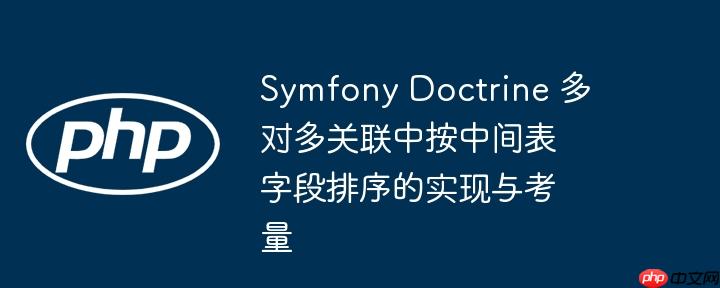
在许多应用程序中,实体之间存在多对多关系。例如,一个产品(Product)可以属于多个分类(Category),而一个分类也可以包含多个产品。在Doctrine ORM中,这种关系通常通过一个中间表(Join Table)来维护,该表存储两个实体的主键。
假设我们有Product和Category两个实体,并通过product_categories中间表关联。现在,业务需求要求在检索某个产品的所有分类时,这些分类需要按照product_categories表中新增的一个serial_number字段进行特定顺序的排列。
以下是初始的实体注解配置:
Product 实体 (Product.php)
<?php
// src/Entity/Product.php
namespace App\Entity;
use Doctrine\Common\Collections\ArrayCollection;
use Doctrine\Common\Collections\Collection;
use Doctrine\ORM\Mapping as ORM;
/**
* @ORM\Entity(repositoryClass="App\Repository\ProductRepository")
* @ORM\Table(name="products")
*/
class Product
{
/**
* @ORM\Id()
* @ORM\GeneratedValue()
* @ORM\Column(type="integer")
*/
private $id;
// ... 其他字段
/**
* @var Collection<int, Category>
*
* @ORM\ManyToMany(targetEntity="Category", mappedBy="products")
*/
private $categories;
public function __construct()
{
$this->categories = new ArrayCollection();
}
public function getId(): ?int
{
return $this->id;
}
/**
* @return Collection<int, Category>
*/
public function getCategories(): Collection
{
return $this->categories;
}
public function addCategory(Category $category): self
{
if (!$this->categories->contains($category)) {
$this->categories[] = $category;
$category->addProduct($this);
}
return $this;
}
public function removeCategory(Category $category): self
{
if ($this->categories->removeElement($category)) {
$category->removeProduct($this);
}
return $this;
}
}Category 实体 (Category.php)
<?php
// src/Entity/Category.php
namespace App\Entity;
use Doctrine\Common\Collections\ArrayCollection;
use Doctrine\Common\Collections\Collection;
use Doctrine\ORM\Mapping as ORM;
/**
* @ORM\Entity(repositoryClass="App\Repository\CategoryRepository")
* @ORM\Table(name="categories")
*/
class Category
{
/**
* @ORM\Id()
* @ORM\GeneratedValue()
* @ORM\Column(type="integer")
*/
private $id;
// ... 其他字段
/**
* @var Collection<int, Product>
*
* @ORM\ManyToMany(targetEntity="Product", inversedBy="categories")
* @ORM\JoinTable(name="product_categories",
* joinColumns={
* @ORM\JoinColumn(name="category_id", referencedColumnName="id")
* },
* inverseJoinColumns={
* @ORM\JoinColumn(name="product_id", referencedColumnName="id")
* }
* )
*/
private $products;
public function __construct()
{
$this->products = new ArrayCollection();
}
public function getId(): ?int
{
return $this->id;
}
/**
* @return Collection<int, Product>
*/
public function getProducts(): Collection
{
return $this->products;
}
public function addProduct(Product $product): self
{
if (!$this->products->contains($product)) {
$this->products[] = $product;
}
return $this;
}
public function removeProduct(Product $product): self
{
$this->products->removeElement($product);
return $this;
}
}中间表product_categories的结构如下:
CREATE TABLE product_categories (
product_id INT NOT NULL,
category_id INT NOT NULL,
serial_number INT DEFAULT 0 NOT NULL, -- 新增的排序字段
PRIMARY KEY(product_id, category_id),
INDEX IDX_FEE89D1C4584665A (product_id),
INDEX IDX_FEE89D1C12469DE2 (category_id),
CONSTRAINT FK_FEE89D1C4584665A FOREIGN KEY (product_id) REFERENCES products (id) ON DELETE CASCADE,
CONSTRAINT FK_FEE89D1C12469DE2 FOREIGN KEY (category_id) REFERENCES categories (id) ON DELETE CASCADE
);我们希望在调用$product->getCategories()时,返回的分类集合能自动按照product_categories.serial_number字段降序排列。
最初的尝试可能是在关联注解上直接使用@ORM\OrderBy,并尝试引用中间表字段,例如:
/**
* @var Collection
*
* @ORM\ManyToMany(targetEntity="Product", inversedBy="categories")
* @ORM\JoinTable(name="product_categories",
* joinColumns={
* @ORM\JoinColumn(name="category_id", referencedColumnName="id")
* },
* inverseJoinColumns={
* @ORM\JoinColumn(name="product_id", referencedColumnName="id")
* }
* )
* @ORM\OrderBy({"product_categories.serial_number"="DESC"}) // 尝试引用中间表字段
*/
private $products;然而,这种做法通常会遇到以下问题:
根据Doctrine的官方文档,@ORM\OrderBy注解用于定义有序集合的默认排序。它接受一个DQL兼容的排序部分数组,但关键在于:字段名必须是目标实体(Target-Entity)的字段名。
这意味着,如果在Product实体中定义$categories集合,并希望通过@ORM\OrderBy进行排序,那么排序字段必须是Category实体上的字段。同样,如果在Category实体中定义$products集合,排序字段必须是Product实体上的字段。
例如,如果Category实体上有一个priority字段,我们可以这样排序:
// 在 Product 实体中
/**
* @var Collection<int, Category>
*
* @ORM\ManyToMany(targetEntity="Category", mappedBy="products")
* @ORM\OrderBy({"priority"="DESC"}) // 假设 Category 实体有 priority 字段
*/
private $categories;对于中间表中的额外字段(如serial_number),直接在ManyToMany关联的@ORM\OrderBy注解中引用是无效的。 @ORM\OrderBy无法直接访问或理解中间表的非关联字段。
当多对多关联的中间表包含除外键以外的额外字段(如排序字段、时间戳等)时,Doctrine ORM的最佳实践是将其转换为两个一对多(One-to-Many)关系,即为中间表创建一个独立的实体(Join Entity)。
这种方法允许你完全控制中间表的每一个字段,并能轻松地进行排序、过滤等操作。
步骤 1: 创建中间实体 (ProductCategory.php)
<?php
// src/Entity/ProductCategory.php
namespace App\Entity;
use Doctrine\ORM\Mapping as ORM;
/**
* @ORM\Entity(repositoryClass="App\Repository\ProductCategoryRepository")
* @ORM\Table(name="product_categories")
*/
class ProductCategory
{
/**
* @ORM\Id()
* @ORM\ManyToOne(targetEntity="Product", inversedBy="productCategories")
* @ORM\JoinColumn(name="product_id", referencedColumnName="id", nullable=false)
*/
private $product;
/**
* @ORM\Id()
* @ORM\ManyToOne(targetEntity="Category", inversedBy="productCategories")
* @ORM\JoinColumn(name="category_id", referencedColumnName="id", nullable=false)
*/
private $category;
/**
* @ORM\Column(type="integer", options={"default": 0})
*/
private $serialNumber; // 注意:这里使用驼峰命名法以符合Doctrine约定
public function getProduct(): ?Product
{
return $this->product;
}
public function setProduct(?Product $product): self
{
$this->product = $product;
return $this;
}
public function getCategory(): ?Category
{
return $this->category;
}
public function setCategory(?Category $category): self
{
$this->category = $category;
return $this;
}
public function getSerialNumber(): ?int
{
return $this->serialNumber;
}
public function setSerialNumber(int $serialNumber): self
{
$this->serialNumber = $serialNumber;
return $this;
}
}步骤 2: 更新 Product 实体
将ManyToMany关系替换为OneToMany关系,指向新的ProductCategory实体。
// src/Entity/Product.php
// ...
class Product
{
// ...
/**
* @var Collection<int, ProductCategory>
*
* @ORM\OneToMany(targetEntity="ProductCategory", mappedBy="product", orphanRemoval=true, cascade={"persist"})
* @ORM\OrderBy({"serialNumber"="DESC"}) // 现在可以对 ProductCategory 实体中的 serialNumber 字段进行排序
*/
private $productCategories; // 更改为指向中间实体集合
public function __construct()
{
$this->productCategories = new ArrayCollection();
}
/**
* @return Collection<int, ProductCategory>
*/
public function getProductCategories(): Collection
{
return $this->productCategories;
}
// 添加/移除关联的方法也需要相应调整
public function addProductCategory(ProductCategory $productCategory): self
{
if (!$this->productCategories->contains($productCategory)) {
$this->productCategories[] = $productCategory;
$productCategory->setProduct($this);
}
return $this;
}
public function removeProductCategory(ProductCategory $productCategory): self
{
if ($this->productCategories->removeElement($productCategory)) {
// set the owning side to null (unless already changed)
if ($productCategory->getProduct() === $this) {
$productCategory->setProduct(null);
}
}
return $this;
}
// 如果仍需要直接获取 Category 集合,可以添加一个辅助方法
/**
* @return Collection<int, Category>
*/
public function getCategoriesOrdered(): Collection
{
$categories = new ArrayCollection();
foreach ($this->productCategories as $productCategory) {
$categories->add($productCategory->getCategory());
}
return $categories;
}
}步骤 3: 更新 Category 实体
同样,将ManyToMany关系
以上就是Symfony Doctrine 多对多关联中按中间表字段排序的实现与考量的详细内容,更多请关注php中文网其它相关文章!

每个人都需要一台速度更快、更稳定的 PC。随着时间的推移,垃圾文件、旧注册表数据和不必要的后台进程会占用资源并降低性能。幸运的是,许多工具可以让 Windows 保持平稳运行。

Copyright 2014-2025 https://www.php.cn/ All Rights Reserved | php.cn | 湘ICP备2023035733号